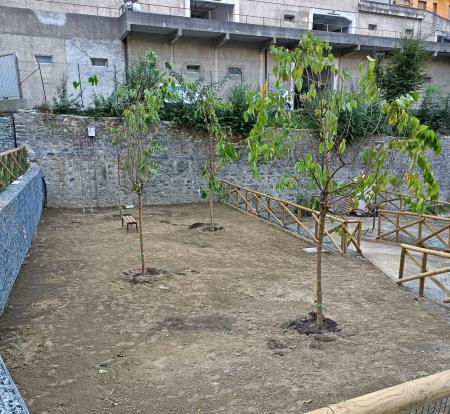
Area characterisation:
The Municipality of Genova has transformed the Gavoglio area in the Lagaccio district into a 10000 m2 urban park. The former military barracks in the area have been demolished and the area has developed into a public, inclusive and sustainable urban park built by almost entirely nature-based solutions. All functions of the park have been designed to be compatible with nature and the project involved the implementation of 12 different nature-based solutions.
Objective:
The city of Genoa experiences acute densification and lack of public green spaces, making urban heat stress a pronounced challenge. Air pollution and biodiversity loss are among the other challenges Genova targeted to address through NbS implementation.
Potential impacts/benefits:
The concentration levels of NO2 and O3 at the reference site in Via Napoli was significantly (1.5 to 3 times) greater than the one recorded in Gavoglio during the current data acquisition period, with a peak in autumn-winter time. Orchard demonstrated moderate contribution to species diversity among all NbS implemented in the Gavoglio area. Survey among the stakeholders indicated that the largest number of respondents (55%) quantified the increase in values for residential properties between 6% and 10%. Approximately 4925 m3 of demolition materials were reused on site.
Actions:
Small plots of the Gavoglio park are used as cultivation areas using drip irrigation systems. An orchard with low irrigation and maintenance needs has been chosen for the park. In order to allow the usability of the areas, a system of ramps and terraces was built by a system of gabions. The fruit trees are placed in a 100x100x100 cm hole filled with topsoil. The trees are structurally maintained by wooden supports that help to stabilise them - the stakes should be driven into the plant hole before planting to a depth of 50-80 cm, one stake if the plant is a shrub or tree less than 1.8 m and 2-3 stakes in other cases. Since the orchard can be assimilated to an agricultural crop, denser planting distance (5x5 m) has been chosen.
Transferability of result:
Drought-resilient orchards require appropriate species selection suitable for the existing climate, sufficient above and below ground space, soil material and depth and temporary or permanent sustainable irrigation facilities.
Lessons learnt:
Nature-based solutions offer an integrative direction for multidisciplinary cooperation, but the cooperation must be facilitated carefully. Citizens are willing to actively participate in co-creation and co-monitoring if tools and means of participant retention are carefully considered and applied.
Organisations:
City of Genova, https://smart.comune.genova.it/
LAND Italia, https://www.landsrl.com/
NBS goals:
- Enhancing sustainable urbanization
- Developing climate change adaptation
- Improving risk management and resilience
- Urban regeneration through nature-based solutions
- Nature-based solutions for improving well-being in urban areas
NBS benefits:
- Reduce drought risk
- Reduce run-off
- Reducing temperature at meso or micro scale
- Carbon sequestration and storage
- Greater ecological connectivity across urban regenerated sites
- Improve connectivity and functionality of green and blue infrastructures
- Increase Biodiversity
- Increase quality and quantity of green and blue infrastructures
- Changing image of the urban environment
- Creation of green jobs relating to construction & maintenance of NBS
- Improve air quality
- Increase accessibility to green open spaces
- Increase amount of green open spaces for residents
- Increase social interaction
- Increase well-being
- Provision of health benefits